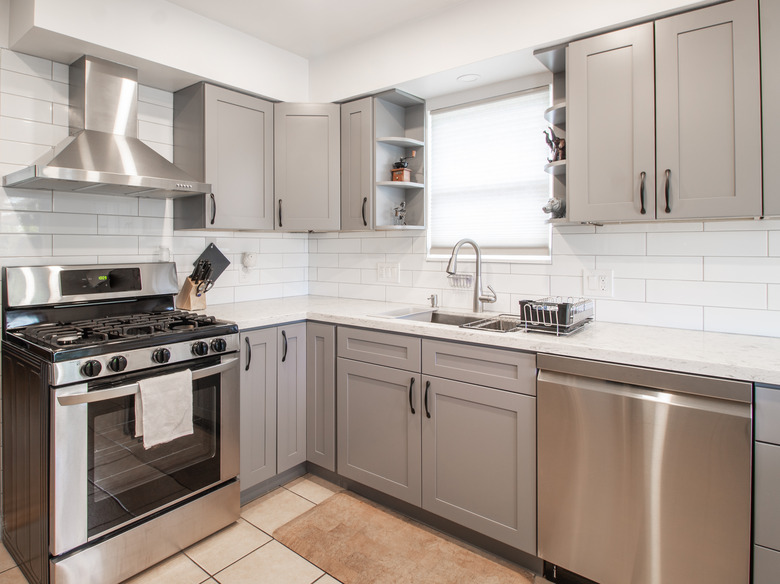How To Locate Your Gas Shut Off Valve
Both natural gas and liquid propane include an additive to give them the smell of rotten eggs, and if you detect this smell, you should shut off the gas, get out of the house and call your gas company. In some cases, you may be able to hear the hiss of escaping gas coming from an appliance or a gas connection, but unable to detect an odor. This is also a dangerous condition that calls for turning off the gas and going outside.
Once you turn off the main gas supply, you'll need a licensed service pro to test your system before you can turn it on again. For this reason, it's best to isolate the leak to a particular appliance and turn off the gas to that appliance rather than turning off the main supply. A gas leak is serious business, though, so if you can't find the source of the leak quickly, don't hesitate to turn off the main supply. By doing so, you'll avert a possible catastrophe.
Where's the Main Gas Valve?
Where's the Main Gas Valve?
The location of your main gas shut-off depends on whether your home uses natural gas or propane (also known as LP gas). If the latter, you have a propane tank somewhere in the yard. Locate it, and you'll find the shut off valve on the top located right next to the gauge that tells you how much gas is in the tank.
If your home is connected to a municipal natural gas system, all the gas lines run from a central meter. It's usually outside right next to the house, but it can also be in the basement or, if you have a slab foundation, in a utility area. If you don't know where it is, follow any gas line from the stove, water heater, or other gas appliance to find it. The utility company's gas valve is usually located on the inlet pipe just before the regulator, which is an oval or round fitting that looks a bit like the starship Enterprise. This valve may have its handle or shutoff nut secured with a wire or tag, but in an emergency you are allowed to break the wire or tag in order to turn off the gas.
There may also be a shutoff valve on the "house side" of the meter, and if it is present, this is the one you should turn off.
Turning Off the Gas Valve
Turning Off the Gas Valve
If your house uses liquid propane gas (LP), locate the main tank and look for the valve. On large horizontal tanks, there may be a dome at the top of the tank, which can be removed to expose the valve. The valve is usually a screw-type handle, often red or yellow, located under this dome. Smaller homes, such as trailers, may have a larger, upright version of the same kind of tank that fuels a barbecue grill. Once you find the valve, turn the handle clockwise fully to shut off the gas. Propane tanks have screw-type valves, so you'll have to turn it through several rotations to turn off the gas. Once the valve has been tightened down, leave it that way until a propane specialist tests your system and turns it back on.
The valves on natural gas meters have ball valves, which means you only have to turn them 90 degrees to shut off the gas. If the valve has a handle, turn the handle until it's perpendicular to the gas pipe. In rare instances, the valves may not have handles have handles. Instead, there's nothing but a large square nut that you have to turn with a wrench. Rotate this nut through 90 degrees to shut off the gas. It usually doesn't matter whether you turn the nut clockwise or counterclockwise, but to be on the safe side, turn it clockwise. If you can't get it to move, then turn it the other direction.
Shutting Off Individual Appliances
Shutting Off Individual Appliances
If you can locate the gas smell as coming from a particular appliance, it's better to turn off the gas to that appliance than it is to turn off the main gas supply — provided you know where it is. Follow the gas line from the appliance to find the in-line shut-off. It's usually a ball valve, which means you turn it 90 degrees to shut off the gas. In most cases, the handle is perpendicular to the pipe when the gas is off.
Warning
Do not waste time looking for an appliance shutoff valve if you don't know where it is and the smell of gas is heavy in the air. If in doubt, shut off the main valve at the gas meter.
The valve on a gas stove or propane refrigerator is usually behind the appliance, and you have to pull the appliance out from the wall and reach behind it to shut off the gas. Be careful not to pull the appliance too far or you risk breaking the gas line. If you can't create enough space to get behind the appliance, turn off the main gas valve instead.
Once the gas is off, turn off the lights and evacuate the room in which the appliance is located — or vacate the entire house — until the gas has dissipated and you can no longer detect the odor. Don't plug anything into an outlet, light a match or lighter or turn on lights until you're sure it is safe to do so. Even the faint spark of an electrical switch making contact can be enough to detonate gas if it is heavy in the air.
